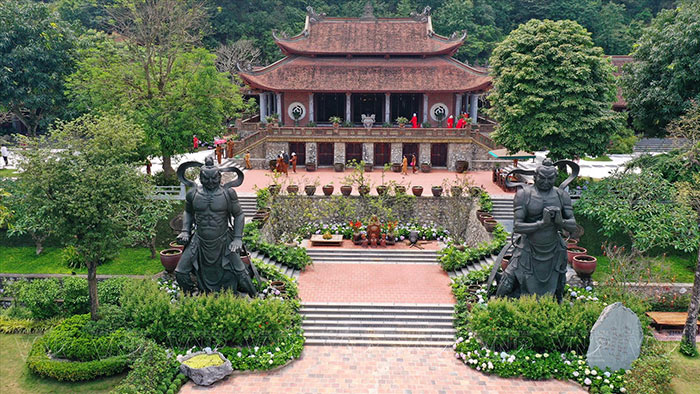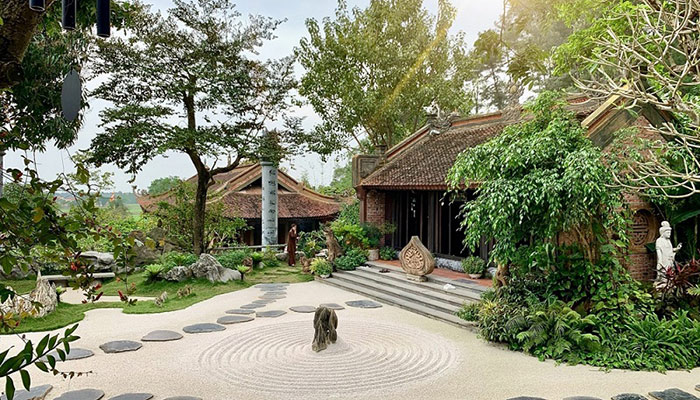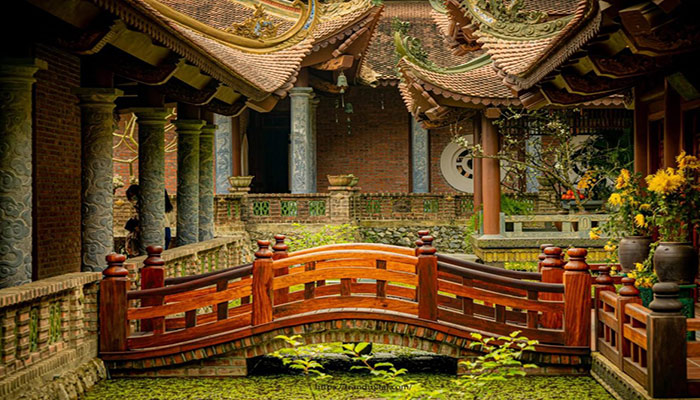Discovering Dia Tang Phi Lai Tu - the Most Beautiful Temple in Ha Nam
When visiting Ha Nam, travelers can indulge in exploring a unique and historically significant temple - Dia Tang Phi Lai Tu. With various nicknames like Phi Lai Dia Tang Temple or just Dia Tang, this temple has existed for over 1000 years. Situated atop a small hill in Ninh Trung village, flanked by the Thanh Long and Huu Bach Ho mountain ranges, and surrounded by lush green pine forests, it creates a serene, mystical, and deeply historical scene, steeped in Vietnamese Buddhist history.

Stepping into the temple's interior, visitors are welcomed by a spacious, flat, and bright space. Uniquely, the courtyard in front of the temple is paved with white pebbles, creating a simple yet picturesque scene. This distinctive feature not only makes Dia Tang Temple stand out but also captivates people with its natural beauty and purity.
Local residents recount that Dia Tang Temple was initially built around the 11th century with over 100 chambers. In the past, King Tran Nghiep Tong chose this location as a hiding place, and even King Tu Duc once visited and prayed here. However, over the years, the temple's architecture gradually deteriorated, and dense vegetation obscured its presence, leading to its neglect.
In December 2015, the temple was received by Venerable Thich Minh Quang, who then undertook restoration and renaming to its current name. The new name of the temple often references the Venerable Dia Tang Vuong Bodhisattva, a deity in Buddhism, although he may never have appeared or may never set foot here. According to Buddhist doctrine, a place where the Venerable Dia Tang Vuong Bodhisattva has appeared and fulfilled his mission will become a sacred place where he will not return.

Dia Tang Phi Lai Tu Temple is nestled amidst a magnificent natural landscape, with winding rivers, adjacent hills, and a small beautiful lotus pond creating focal points in the courtyard. The overall space of the temple resembles a part of nature, as a part of the majestic forest. In front of the main hall of the temple, there are 12 circles drawn on the stone, symbolizing the 12 causes and conditions of human life. Each circle bears a small signboard that reads "Ocean of suffering, as an ocean, please walk on the shore", gently reminding people to choose a path on smooth stones instead of stepping on gravel. The white stones carry profound significance in meditation. That's why, when strolling around the courtyard, just looking at the pure white stones, one's heart becomes peaceful and serene. The image of the Venerable Dia Tang appears with a kind and dignified appearance, sculpted from brown, gold, and white colors at Dia Tang Phi Lai Tu Temple.
Within the temple's grounds, visitors can also explore fruit gardens, herbal gardens, and wild vegetable gardens meticulously cared for and managed by locals and monks. Additionally, at the foot of the mountain, Dia Tang Phi Lai Tu Temple also has a mushroom cultivation house covering about 20m2, providing clean food sources for vegetarian hot pots or vegetarian pâté. For those passionate about books, especially mystical and spiritually nourishing works, Dia Tang Phi Lai Tu Temple is an ideal place amidst the world with a diverse, rich collection of books covering most of its walls. Besides, when in need of fresh air, you can relax and enjoy tea in the meditation garden, lying on a hammock or sitting on a stone bench, admiring the temple from above.

At Dia Tang Phi Lai Tu Temple, roof tiles are decorated with unique patterns such as lotus flowers, dragons, mythical birds, and phoenixes. Mythical creatures and antiquities are vividly reproduced, taking people back to the historical period of the Ly and Tran dynasties. The image of the lotus flower, with its pointed tip facing upwards, is a characteristic symbol of art from the 11th to the 14th centuries. The Garuda-shaped roof tiles are also symbols of the universe and greatness. Furthermore, the most prominent feature of the temple is its harmony with nature. The largest building, the Tam Bao Hall, houses the statue of the Venerable Dia Tang in the center. Besides, to the right of the main temple is the self-worship area of 42 resident patriarchs of the temple. The complex also includes many other special architectural structures such as the Duc Ong Palace, the Duc Thanh Dao Hien Palace, the Phat Quan The Palace, residential areas for monks, and a hall for Buddhists to listen to lectures and organize retreats. On the top of Phi Lai mountain, there is the Pho Dong tower built from the Ly Tran period, where 40 generations of patriarchs rest. When the sunlight shines, you can see the shadow of the tower stretching from the Dia Tang village to the Thap village.
Ha Nam is one of the enticing choices for your spring trip. It is not only a destination to admire the beauty of ancient architecture and experience traditional culture but also a place where you can relax and enjoy everyday life. To ensure your trip goes smoothly and is the best experience, Tiến Lộc Palace Hotel is the perfect choice. Located in the heart of Phu Ly city, you can easily travel to various attractions and experience local culture. This 3-star hotel provides full amenities and the most attentive customer service.










